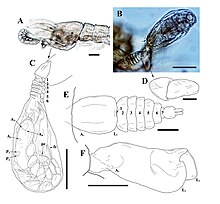Tantulocarida
| Tantulocarida | |
|---|---|

| |
| Microdajus sp. | |
| Scientific classification | |
| Domain: | Eukaryota |
| Kingdom: | Animalia |
| Phylum: | Arthropoda |
| Superclass: | Multicrustacea |
| Class: | Tantulocarida G. A. Boxshall & R. J. Lincoln, 1983 [1] |
| Families | |
| |
Tantulocarida is a highly specialised group of
Description
This section needs expansion. You can help by adding to it. (June 2018) |
Eyes are completely absent.[4]
The tantulus larvae has a head with a ventral oral disc but no appendages, a six-segmented thorax with six pairs of legs, and a limbless abdomen consisting of one to six segments in addition to a telson.[5]
Body length
Members of this subclass are minute – less than 0.3 millimetres (0.012 in) in length and have a dramatic reduction in body form compared to other crustaceans, with an unsegmented, sac-like thorax and a much reduced abdomen.[6] One tantulocarid species, Tantulacus dieteri, is the world's smallest arthropod, with a total body length of only 85 micrometres (0.0033 in).[7]
Life cycle
This section needs expansion. You can help by adding to it. (June 2018) |
The tantulocarid life cycle is unique among crustaceans. The tantulus larva transforms directly from a non-feeding (lecithotrophic) and free-swimming organism into a parasite without any instars. When entering the parasitic stage much of the body, such as the muscles, degenerates, even if the body itself becomes bigger. As a parasite it is permanently attached to its host, and after piercing its host's cuticle with an unpaired stylet, a rootlet system used to absorb nutrients enters through the hole and grow into the host’s tissue. The adult form develops inside the larva, and can become either a sac-like parthenogenetic female, or a fully developed free-living, non-feeding and sexually-reproducing male or female.[8][9][10][11][12] The eggs inside the parthenogenetic female are eventually released as fully developed tantulus larvae. The finding of what appears to be a benthic non-feeding nauplius larva suggests that eggs produced by sexual females hatch as nauplii instead of tantulus larvae. Both the parthenogenetic and sexual females are semelparous.[13]
Classification
Five families are recognised:[14]
|
Basipodellidae Boxshall & Lincoln, 1983:[15]
Doryphallophoridae Huys, 1991:[16]
Microdajidae Boxshall & Lincoln, 1987:[17]
|
|
References
- ^ "Tantulocarida". Integrated Taxonomic Information System.
- ^ "WoRMS - World Register of Marine Species - Tantulocarida". www.marinespecies.org. Retrieved 2019-06-28.
- JSTOR 1547849.
- PMID 11818548.
- ^ Multicellular Animals: Volume II: The Phylogenetic System of the Metazoa
- McGraw-Hill. Archived from the originalon 2011-06-17. Retrieved 2016-09-10.
- S2CID 7325858.
- JSTOR 2396610.
- ^ Anatomy of the free tantulus larva (Crustacea: Tantulocarida) studied with confocal laser scanning microscopy: An extreme case of miniatuarisation in the Arthropoda
- ^ Itoitantulus misophricola gen. et sp. nov.: First Record of Tantulocarida (Crustacea: Maxillopoda) in the North Pacific Region
- ^ Tantulocaridan Life Cycle: the Circle Closed? - Oxford Academic
- ^ Anatomy of the Tantulocarida: first results obtained using TEM and CLSM. Part I: tantulus larva - GfBS
- ^ Atlas of Crustacean Larvae
- ^ WoRMS. "Tantulocarida". World Register of Marine Species. Retrieved 13 December 2022.
- ^ Geoff Boxshall (August 20, 2008). T. Chad Walter & Geoff Boxshall (ed.). "Basipodellidae". World Copepoda database. World Register of Marine Species. Retrieved 2016-09-10.
- ^ Geoff Boxshall (August 20, 2008). T. Chad Walter & Geoff Boxshall (ed.). "Doryphallophoridae". World Copepoda database. World Register of Marine Species. Retrieved 2016-09-10.
- ^ Geoff Boxshall (August 20, 2008). T. Chad Walter & Geoff Boxshall (ed.). "Microdajidae". World Copepoda database. World Register of Marine Species. Retrieved 2016-09-10.
- ^ WoRMS. "Cumoniscidae Nierstrasz & Brender à Brandis, 1923". World Register of Marine Species. Retrieved 13 December 2022.
- ^ Geoff Boxshall (2012). Walter TC, Boxshall G (eds.). "Onceroxenidae". World of Copepods database. World Register of Marine Species. Retrieved 2016-09-10.
External links
 Data related to Tantulocarida at Wikispecies
Data related to Tantulocarida at Wikispecies
